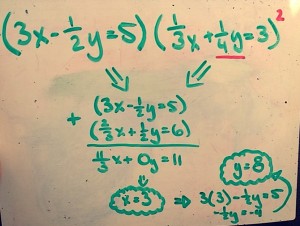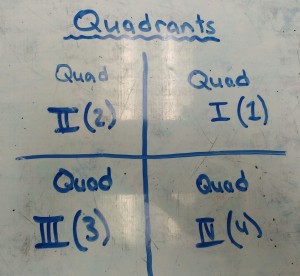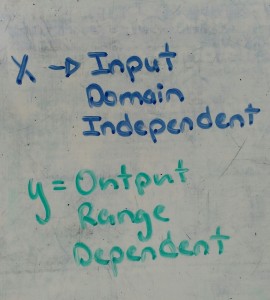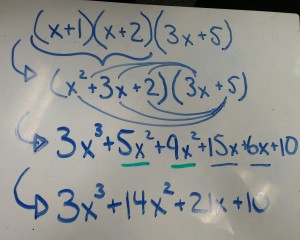I thought it was going to be hard trying to multiply a fraction in order to get a zero pair but it was actually easy. If the 1/4 were to be multiplied by 3, it would be 3/4 which is not 1/2 so try a different # to multiply with. Maybe 4? No, that would equal 1. Maybe 5? No. Maybe 2? Yes! Because if you multiply the top # by 2, it would be 2/4 y = 1/2 y !
Tag Archives: Burtonmath10
Week 14 – math 10
A question that really stumped me up was “Determine the value of k”
Question: U(2,5) V(k,3) with a slope of 2/7
Slope being rise over run.
Rise, you have to find the difference between y1 (5) and y2 (3) which is simple, 2. Run, you don’t know what k is so you just leave it with 2-k. This is where things got tough for me, I didn’t know what the next step was but then I remembered… You always was the variable to be the top, the numerator. How to do that? One reciprocates; but what you do to one side, you must do to the other (step 3). Now, It’s just basic algebra; you want to get k all by itself. What you are doing in dividing by 2 so to get rid of 2, you must multiply both sides by 2. What’s left is 7=2-k. Take 2, bring it to the other side which becomes negative. Step 5, you don’t want to end up with a negative variable so divide each side by -1 which gives you the missing #, -5.
Week 13 – math 10
Week 12-math 10
2 questions that I really did not get were these two^^. But once I found out what they were asking, I started to slowly understand it. First and foremost: What does discrete and continuous mean?
The answer is:
Discrete data is counted.
Continuous data is measured.
When looking at the independent variable (x), the discrete variable could be kids in a class because there can’t be half of a student and everyone is unique. Another example is a dice; there are only be 6 possible answers. Continuous data can take any value (within a range) for example time in a race, or the height of my cat. There is an infinite amount of time because there could be 1.5secs, 1.4seconds, 1.345secs etc…
Week 11- math 10
Video tutorial for math 10.
Week 10 – math 10
Multiplying 3 binomials is easier than it looks, you just need patience. If they are all getting multiplied (expanded), it doesn’t matter which ones you are multiplying first. In the example below, I chose to multiply the easier ones first: (x+1)(x+2)=(x^2+3x+2). Next comes multiplying the binomial and the trinomial to get rid of the brackets. To do that, you have to do the distributive property (and here is where the patience comes in). Do that you still have a huge mess! You have to clean it up by putting together like terms.
Patterns in Polynomials
How patterns make multiplying and factoring polynomials easier?
- Algebra tiles are helpful when trying to figure out which signs are being multiplied.Whenever there’s a positive and a positive multiplying for example (x+2)(x+3), the algebra tiles will all be colored in.
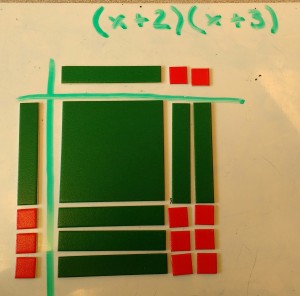 Whenever there’s a negative and a positive multiplying for example (x-2)(x+3), the algebra tiles will look like half is colored and half is not.
Whenever there’s a negative and a positive multiplying for example (x-2)(x+3), the algebra tiles will look like half is colored and half is not.
Lastly, whenever there’s 2 negatives multiplying for example (x-2)(x-3), the algebra tiles will look like half colored, half not, half colored and half not.  When factoring polynomials, you have to make sure the second term is half of the first term for example, x^2+5x+6 (the variable in the middle needs to have half of the number of x’s as the leading term). An example that would not factor would be (x^3+5x+6) because x^3 is 3 times x, not 2. How you get x^2 is by multiplying (x)(x), how you get 6x is adding the constants together and x, and finally how you get 8 is by multiplying the constants (so that means the #s have to multiply to one # and add to the other). Notice it’s using the same variable.
When factoring polynomials, you have to make sure the second term is half of the first term for example, x^2+5x+6 (the variable in the middle needs to have half of the number of x’s as the leading term). An example that would not factor would be (x^3+5x+6) because x^3 is 3 times x, not 2. How you get x^2 is by multiplying (x)(x), how you get 6x is adding the constants together and x, and finally how you get 8 is by multiplying the constants (so that means the #s have to multiply to one # and add to the other). Notice it’s using the same variable. 
 Doesn’t matter which order they are in. 2+3+5 gives the same answer as 3+2+5…
Doesn’t matter which order they are in. 2+3+5 gives the same answer as 3+2+5…
 Other quick tips… to factor an equation with only 2 terms, it would have to have conjugates and a negative. Example (x-4)(x+4) = x^2-16 (two terms). And double patterns are a thing!—— x^2+4xy+3y^2=(x+y)(x+3y)
Other quick tips… to factor an equation with only 2 terms, it would have to have conjugates and a negative. Example (x-4)(x+4) = x^2-16 (two terms). And double patterns are a thing!—— x^2+4xy+3y^2=(x+y)(x+3y)
Week 9 – math 10
Question: Determine a simplified expression of the shaded area in terms of a and b?
If (5a+b) is the whole length of one side, that means length of the shaded rectangle would be (5a+b-a-a). That equation simplified is (3a+b). Same thing for the height. If it’s (3a-b), that means that the height of the shaded rectangle is (3a-b-a-a) which simplifies to (a-b). Multiply (3a+b) with (a-b) and it gives you the area of the shaded rectangle which is 3a^2-2a-b^2. 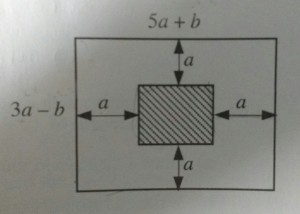
Week 4 – math 10
Once you learn the basics of scientific notation questions are pretty straight forward but questions that have zeros in front of number’s really stump me up. Questions like  . When you do scientific notation, you take the comma and move it after the first actual number. You count how many times you moved the comma and write it as an exponent of 10. With numbers like above, you would do the same thing. Take the comma, move it after the very first real number then count how many times you moved it. But it wouldn’t be a positive exponent, it would be a negative. So the answer to the above question is 3.9×10^-3.
. When you do scientific notation, you take the comma and move it after the first actual number. You count how many times you moved the comma and write it as an exponent of 10. With numbers like above, you would do the same thing. Take the comma, move it after the very first real number then count how many times you moved it. But it wouldn’t be a positive exponent, it would be a negative. So the answer to the above question is 3.9×10^-3.
Week 3 – math 10
This question was a tricky question. I was so confused at the beginning. 
So, I went to miss Burton and asked her how to do it and she showed me something that I would never even think about. She explained that usually you would do the equation on the inside and work your way out but, to make life easier, she said multiply both indexes which would be 6, and now to the question is so easy. Which # times itself = 64? 2!

